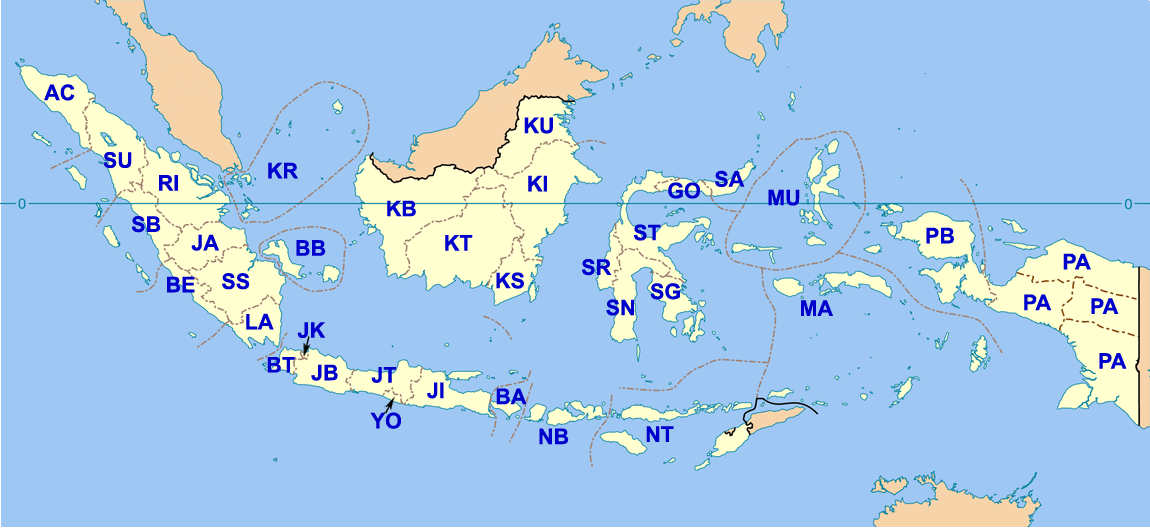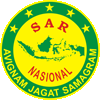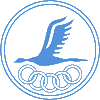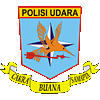Brief history
The Japanese occupation of the Dutch East Indies, on March 8, 1942, initiated the final stage in Indonesia's quest for independence. With Japanese support, the popular Ir. Sukarno formed a large militia ready to fight the Dutch on their return after the war. On August 17, 1945, Sukarno ended 350 years of Dutch colonial rule by proclaiming the free REPUBLIK INDONESIA. On April 9, 1946, the fledgling state, at war with the Dutch, formed its own Air Force, named ANGKATAN UDARA REPUBLIK INDONESIA, or AURI.
Aircraft used from 1945 until 1950 were mainly of Japanese Army and Navy origin and reclaimed from large dumps all over Java. The AURI order of battle in 1945/46 included some 100 aircraft of many different types, including the Ki51 Guntai, Ki43 Hayabusha, Ki36/55 Cukiu, K5Y1 Curen and Ki79B Nishikoren. No more than thirty to fifty aircraft were ever operational, and they were mostly used for pilot training. Two strong Dutch offensives against the Indonesian Republic in July 1947 and December 1948 completely destroyed the small air arm. Although the Republic was facing a military defeat, international outcry and -pressure prevailed, and on December 27, 1949, the Republic of Indonesia gained its sovereignty from The Netherlands.
In late 1949-early 1950, approximately 253 ex ML-KNIL and MLD aircraft revived the AURI and a major reorganisation took place, with the formation of the first squadrons, or Skadron Udara (SkU). mportant types (quantity) received included:
- B-25C/D/J (42) with SkU.1 based at Tjililitan (now Halim Perdanakusuma, Jakarta)
- C-47 (34) with SkU.2 based at Andir (now Husein Sastranegara, Bandung) and with SkU.5 based at Tjililitan
- P-51D/K (26) with SkU.3 based at Tjililitan
- Auster (22) with SkU.4 based at Semplak (now Atang Senjaya, Bogor)
- AT-16 (26) with SPL based at Andir and with SkU.5 based at Tjililitan
- L-4J (63) assigned to all squadrons and with Pilot School based at Kalidjati (now Suryadarma, Subang)
On February 20, 1956, the AURI entered the Jet age, when eight Vampire T-55s entered service with what later became SkU11 at Husein Sastranegara. Ever since the Proclamation of Independence, domestic unrest has been one of the driving forces for the development of the Air Force. In 1958, outlying provinces of Indonesia trying to break away from the central government with CIA support were crushed one by one with the use of airpower. The former ML-KNIL aircraft played a major role, such as on May 18, 1958, when Captain Ignatius Dewanto, flying F-51D F-338 from Amahai, shot down CIA mercenary Allen Pope in an AUREV/CIA B-26B over Ambon harbour. The CIA pilot was taken prisoner and exchanged for C-130Bs in July 1962.
Indonesia's first President, Ir. Sukarno, also confronted the Dutch in New Guinea in 1962, and the Malaysian Federation between 1963 and 1966. To support his plans, he started a re-equipment program in 1958. Thirty MiG-15UTIs (Czech CS-102), 32 Il-28/R/Us and 21 IL-14/Avia-14s arrived in Jakarta, ordered from Czechoslovakia. These were later augmented with a large number of Mi-4s and nine Mi-6s from the Soviet Union. Also Poland provided arms for the Republic. During 1958 and 1959 some thirty LIM-5s and seven LIM-5P fighters were delivered, together with eight SM-1 (Mi-1) helicopters. Polish pilots also flew fourteen Avia B-33s (IL-10) for a few years. Finally, China delivered twelve MiG-17Fs (known as Model 56), twelve Tu-2s, 24 La-11s and three La-9UTIs, although the latter three models saw little service. More large orders for Soviet arms were placed in 1961. These included 26 Tu-16 bombers, ten MiG-19s, twenty MiG-21s and six An-12BPs, thus introducing the AURI to the supersonic jet age. The only aircraft to arrive from the US, apart from ten K/C-130Bs traded for the captured CIA pilot, were six B-26B Invaders in 1960, and about twenty P-51D Mustangs from 1958.
Again, global politics played a deciding role in the conflict over Dutch New Guinea. In early August 1962, it became clear that deployment targets for an Indonesian invasion of Dutch bases could not be met. Also, US U-2 recce planes were spotted over Indonesia, and Soviet submarines were known to support the Indonesian Navy. After the personal intervention of President Kennedy, President Sukarno cancelled the operation in August 1962, and the Dutch government was forced to deliver Dutch New Guinea into UN hands. Renamed Irian Jaya under Indonesian rule, the territory remains a hot-spot to the present day. A new conflict involving the greatly expanded and modernised AURI began to unfold in 1963, when Malaya, Singapore, Sarawak, Brunei and Sabah formed the Malaysian Federation. In May 1964, President Sukarno called for the destruction of this Federation, and initiated a command that intensified infiltrations into Sarawak and Malaysia. However, after the loss of two C-130Bs in 1964 and 1965, infiltration by air was stopped.
Ever since the first arms were delivered by the communist Eastern Bloc in 1957, the strength and influence of the Indonesian Communist Party (PKI), had grown considerably. On September 30, 1965 a violent Coup d'Etat was attempted in the capital Jakarta. With the murder of 6 high-ranking and one junior army officer, the history of Indonesia took a new turn. Within days, the army's Strategic Command under Major-General Suharto, later to become Indonesia's second president, defeated the rebels. The PKI was accused of the failed Coup attempt, and also air force Commander Omar Dani was arrested after the AURI was accused of active support. A bloody crackdown on PKI supporters followed all over Indonesia, and many tens of thousands were killed. This also meant the end of Communist support for the armed forces. Only in recent years have retired AURI members been able to speak out freely about this dark episode in their history, and make clear that the AURI was never involved. At the time of the coup, the AURI had reached its peak strength, and was considered, in numbers, to be the largest Air Arm in SEA. In 1965, the AURI Order of Battle looked like this:
- SkU.1 B-25C/D/J, B-26B Abdulrachman Saleh, Malang
- SkU.2 C-47, IL-14/Avai -14, L-12A Halim Perdanakusukma, Jakarta
- SkU.3 P-51D/K, AT-6/AT-16 Abdulrachman Saleh, Malang
- SkU.5 UF-1, PBY-5, G-21A Abdulrachman Saleh, Malang
- SkU.6 Mi-4 Husein Sastranegara, Bandung
- SkU.7 Mi-4, SM-1, S-61V-1, Bell-47G-2/J, Bell 204B Semplak, Bogor
- SkU.8 Mi-6 Semplak, Bogor
- SkU.11 CS-102, MiG-17F, LIM-5, LIM-5P Abdulrachman Saleh, Malang
- SkU.12 MiG-19S, MiG-21F-13 Kemayoran, Jakarta
- SkU.14 MiG-21F-13 Iswahjudi, Madiun
- SkU.17 IL-14, DHC-3, PBY-5, C-47, UF-1, L-1329 Halim Perdanakusuma, Jakarta
- SkU.21 IL-28, IL-28R, IL-28U Abdulrachman Saleh, Malang
- SkU.31 C-130B Halim Perdanakusuma, Jakarta
- SkU.32 An-12B Husein Sastranegara, Bandung
- SkU.41 Tu-16 Iswahjudi, Madiun
- SkU.42 Tu-16KS-1 Iswahjudi, Madiun
- WP.001 T-34A, T-6 versions, L-29 Adisucipto, Yogyakarta
In August 1966, the Malaysian Federation and Indonesia ended the Confrontation. The years between 1966 and 1969 were one of the most difficult in AURI history. It had to regain the government's confidence, and rebuilt its forces without Communist support. After many fatal crashes, most of its Eastern Bloc aircraft were withdrawn from use by 1970. A recovery program was initiated for the B-25, B-26 and C-47, additional F-51s were purchased, and the C-130 became the backbone of the AURI. General Suharto, who had regained support from the US, became Indonesia's second president on March 27, 1968.
In 1973, eighteen second-hand CAC-27 Sabres arrived from Australia, as well as sixteen USAF surplus T-33As and twelve Vietnam War veteran UH-34Ds. They marked the beginning of the third revival of the air force, having been renamed TNI-AU in early 1974. The Sabres and the T-33s replaced respectively the unserviceable MiG-21 and CS-102/LIM-5/MiG-17. The only other (tactical) fighter still in service was the venerable Mustang, eight additional Cavalier T/F-51Ds having been delivered to SkU.3 in 1971 and 1973. However, after several fatal crashes they were grounded in 1975. Replacement came in the shape of another wild horse, the OV-10F Bronco which arrived in September 1976.
In April 1974, the fascist Caetano regime in Lisbon, Portugal, was overthrown. This initiated civil unrest in Portuguese East Timor, or Timor-Timur, and a civil war erupted in the capital Dili, between pro Portugal troops and FRETILIN, the independence movement. In the mean time, Indonesia had launched a secret intelligence and destabilisation operation, and immediately took advantage of the situation. On November 28, 1975, Fretilin proclaimed the Democratic Republic of East Timor, but on December 7, Indonesia started OPERASI SEROJA, the invasion of Timor-Timur. That day nine C-130Bs from SkU.31 and six C-47s from SkU.2 departed Adisucipto for Dili and Baucau, and 1000 paratroopers were dropped near Dili. A pro-Indonesian government was formed and Timor-Timur became an Indonesian province. Fretilin opposition continued into 1976 and in September, the first of sixteen OV-10F COIN aircraft were delivered to SkU.3. They were frequently used in Timor-Timur from 1977, together with the A-4E and F-5E, as opposition to the Indonesian occupation never seized. Following the economic recession of 1998 and the election of Indonesia's third President Prof Dr Ing Habibie, independence for East Timor became a possibility again. After a referendum on August 30, 1999, Timor Loro Sae, or Timor of the Rising Sun, became independent from Indonesia.
From 1976, the TNI-AU has seen a continuous period of modernisation and expansion. In 1980, the TNI-AU started replacing its venerable fighter force, when three new types entered service. On April 21, the first of twelve F-5Es and four F-5Fs arrived, as replacement for the CAC-27 Sabres with SkU.14. Also arriving in April 1980, were fourteen A-4Es and two TA-4Hs from surplus IDF/AF stock. They replaced the T-33A with SkU.11. In September, the first Hawk Mk53s were delivered to Wing Pendidikan 1, and were operated next to the L-29. The Delfin soldiered on until 1983, when they were stored after twenty years of continued use, being the last Soviet Bloc type to be withdrawn. In 1982, SkU.12 was reactivated with the second batch of sixteen ex-IDF/AF A-4E Skyhawks. SkU.31 was re-equipped with the new C-130H-30 from September 1980. In 1982, the patrol unit SkU.5 at last received more modern equipment, when the first of three B737-2X9s arrived, followed by a single C-130H-MP. This signalled the end for the UF-1/2 fleet, which was used until approximately 1987. SkU.4 was re-activated in April 1985, flying a total of ten NC212M-100/200s and seven Ce401/402s.
A dozen former Pelita H-500Cs were delivered to SkU.7 in December 1982, operating next to the Bell 47Gs received from Australia in 1978. In 1981, SkU.6 transferred its new Puma fleet to the reactivated SkU.8, while retaining the re-engined UH-34Ds better known as the S-58T. AS202 Bravos replaced the last T-34A Mentors with WP.1 from March 1981. They are used as elementary trainers, with basic training reserved for the T-34C since 1978. As part of a large reorganisation, all airforce squadrons were concentrated in two operational commands on April 1, 1985; Komando Operasi Angkatan Udara (KOOPSAU) I in Jakarta (for the Western part of Indonesia), and KOOPSAU II in Ujung Pandang (for the Eastern part of Indonesia). In 1989, a contract was signed with Boeing to upgrade the B737-2X9s in use with SkU.5. The modifications included an update of the Motorola SLAMMR, Side Looking Airborne Modular Multi-mission Radar. Aircraft AI-7301 was modified by Boeing and delivered by October 1993. Program MACAN (Indonesian for TIGER), or Modernisation of Avionics Capabilities for Armament and Navigation, is a major upgrade program involving the F-5Es and F-5Fs forming SkU.14. In 1995, a contract was signed with SABCA of Belgium. The first two aircraft arrived at Gosselies in May. Far behind schedule, test flying started in September 1997, and both aircraft returned to Indonesia in February 1999.
The first of eight F-16As and four F-16Bs were delivered in December 1989. These aircraft replaced the OV-10F in SkU.3, and the Broncos were used to reactivate SkU.1. In November 1995, the air force expressed a requirement for 64 F-16s to equip four squadrons, and showed an interest in the Pakistan Airforce F-16s stored at AMARC. After an initial agreement, President Suharto cancelled the deal in June 1997. Early August 1997, Jakarta announced the decision to purchase twelve SU-30KIs similar to the version delivered to India, with potentially an option for eight more. However, due to the monetary crisis, the deal was postponed in January 1998 until it resurfaced again in 2003, see later. The last A-4s of SkU.12 were transferred out in 1996, and the best aircraft were concentrated in SkU.11. Two ex AMARC TA-4Js were purchased, and after an upgrade in New Zealand they were delivered in October 1999. In June 1993, the TNI-AU ordered eight Hawk Mk109s and sixteen Hawk Mk209s from BAe. The air force requirement over the next 25 years was reported to be 96 armed Hawks in eight squadrons, funds permitting. In May 1996, the first three Hawk Mk109s for SkU.12 arrived in Indonesia. In June 1996, an option for sixteen additional Hawk Mk209s was exercised by the TNI-AU, and the first were delivered from April 1999 to the relocated SkU.1 at Pontianak, replacing the OV-10F. They remained in use with the Unit OV-10 Bronco. This used to be the Bronco Flight until renamed SkU.21 on September 11, 2004. However, after a fatal accident on July 21, 2005 the Bronco was withdrawn from operational tactical use and the unit was again renamed on July 26. After another fatal crash on July 23, 2007, the Bronco was grounded indefinitely.
Also the transport and patrol units have seen new material arrive and leave. The remaining F27-400Ms of SkU.2 were supplemented by IPTN CN235-100Ms from January 1993. Three CN235-220-AMCOS (MPA) patrol aircraft for SkU.5 are part of a joint TNI-AU and TNI-AL order revealed in June 1996, and one was delivered in June 2008. The VIP unit SkU.17 added two stretched IPTN NAS332L1 Super Pumas (VVIP models) to its fleet in 1993, followed by two ex Garuda F28-3000s in 1994 and two AS332L2s from Eurocopter in 2002. Also the two Merpati L100-30 Hercules transports were passed on to SkU.17, and three L100-30s moved from Pelita to the TNI-AU in 1997. In November 2004, the sole SkU.17 B707-3M1C was sold and replaced by a B737-2Q8 in February 2005. On the helicopter front, the H-500Cs from SkU.7 were sold in the US in early and mid 1996. In June 1997, an order for sixteen IPTN NAS332 Super Pumas was placed, comprising one VVIP, two VIP, seven Tactical Transports and six Combat SAR models. The first Tactical Transports were delivered to SkU.6 in September 2001 starting the replacement of the S-58Ts which were finally grounded after a fatal crash in 2008. Parallel to the delivery of the new Super Pumas, the TNI-AU has also embarked upon an upgrade and re-engine program for (at least) three older IPTN produced NSA330L Pumas. On February 27, 2004, the first Makila powered and redesignated NSA330SM arrived with SkU.8.
The TNI-AU formed a new demonstration team in 1995 with F-16s from SkU.3, known as Elang Biru (Blue Falcon). All aircraft received a striking blue/yellow colour scheme from December 1995. However, the team has been disbanded and the F-16s have received new (Millennium) colours in early 2000. A second display team, Team Jupiter, was formed on September 23, 1997, flying eight Hawk Mk53s from SkaDik.103. Today, also the Hawks, who are now part of SkU.15 in a tactical role, have received new colours (Gray Spot) similar to the F-16s. In April 2001, the two demo teams were merged into one and named Jupiter Blue, flying three Hawk Mk53s, two F-16s and a single Hawk Mk109. After a fatal collision between two Hawk Mk53s on March 28, 2002, the team was disbanded. In May 2000, the TNI-AU revived the Wing structure for bases with two or more squadrons. On May 5, 2000, Wing 3 was formed at Iswahjudi, with other wings based at Halim (Wing 1), Abdulrachman Saleh (Wing 2) and Atang Senjaya (Wing 4).
In October 2000, word broke of a possible transfer of nineteen former Singapore Airforce SF260s to the TNI-AU. They are seen as a compensation for the use of Indonesian airspace and facilities by the Singapore Air Force. The first six arrived on July 2, 2002, for use as special trainers by SkU.2. In February 2003, ten aircraft moved out to Suryadarma. However, it appears that they were grounded within a few years. Also announced was the acquisition of the Eurocopter EC-120B Colibri as a replacement for the H-500s of SkU.7 at Suryadharma. The first two of twelve ordered arrived in December 2001. In January 2001, the TNI-AU embarked upon a program to modernise its elementary and basic trainer fleet. It was announced that twenty KAI KT-1B Trainers are to be acquired, with seven to be delivered between May and November 2003. First flight of a TNI-AU KT-1B took place in december 2002, and the first aircraft entered service with SkaDik.102 on July 14, 2003. Five additional aircraft were assembled in Bandung in 2007. They replaced some of the T-34Cs with WP-1.
In a surprise move during a visit to Russia, Indonesian President Megawati Sukarnoputri signed a contract for the delivery of two Su-27SKs and two Su-30MKs in April 2003. The two Su-27s arrived with SkU.15 at Iswahjudi on August 27, followed by the two Su-30s on September 1. They were officially handed over on September 20, 2003. In August 2004 the TNI-AU finally said farewell to the A-4 Skyhawk as the last few operational examples were withdrawn from use by SkU.11 at Hasanuddin. On April 12, 2005 they were replaced by the Flankers as they moved in from Iswahjudi to claim their new hangar. On December 26, 2008, the first two of three Su-30MK2s arrived, followed by three Su-27SKMs in September 2010. This brings the total to ten Flankers in service by late 2010.
More recent acquisitions include eight former Australian Hercules transport aircraft, the patrol version of the C295, H225 helicopters and 24 F-16C/D-52ID sourced from the United States. The last of these were delivered in January 2018. With regard to the training syllabus, this was rejuvenated aswell with 24 Grob 120TP trainers and the withdrawal from use of the venerable T-34C-1 on 3 April 2018. Most exiting is of course the order for eleven Su-35S. Delivery of the first two is expected by late 2018.










